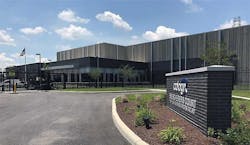After years as a regional colocation specialist, Cologix is seeking a higher profile in the North American market for interconnection services. With the support of its new ownership, Cologix is building bigger data centers, eyeing new markets, and positioning itself as a key provider of on-ramps to major clouds.
Private equity firm Stonepeak Infrastructure Partners acquired Cologix in early 2017, calling it “a marquee platform to enter the data center and interconnection market in North America.” Stonepeak says it will invest $500 million in the growth of the Cologix platform.
That investment will help Cologix gain scale and breadth in the competitive market for colo and interconnection services. The company currently operates 24 data centers across nine markets in the United States and Canada, and is notable for its focus on carrier-neutral connectivity hubs in regional markets.
Last month Stonepeak appointed Bill Fathers as the new CEO of Cologix to carry out the mission. Fathers says the strategic roadmap for Cologix is more of the same – only at larger scale, with bigger data centers in more places.
“Our strategy is to keep doing what we’re already doing well,” said Fathers, “The future of the company is to continue to grow our capacity to serve these interconnection customers. We’ll probably look to expand into some new markets as well.”
Ashburn Project in the Works
Cologix has not made any announcements about new markets. But public documents indicate that one focus of its expansion will be Ashburn, Virginia, in the heart of the country’s largest concentration of cloud computing infrastructure.
Cologix has filed preliminary plans with Loudoun County to build a 140,000 square foot data center on a property on Beaumeade Court in Ashburn, which is currently the home of the Christian Fellowship Church (CFC).
The CFC property sits next to the world’s largest Internet intersection, adjacent to campuses for Equinix, Digital Realty and Amazon Web Services. Last September, church members voted to approve a sale of the property to a data center company, and use the proceeds to relocate to a new facility near their current location. The church said the purchaser had agreed to a timetable in which it would continue to use its existing facility until sometime in 2020.
The church has not revealed the identity of the potential buyer, but converting the site to data center use required a minor zoning change, which revealed Cologix’ interest. The zoning change was approved by the Loudoun County Board of Supervisors in June.
Fathers declined comment on the Ashburn site, but said Cologix will be announcing expansions to support its focus on interconnection and cloud on-ramps.
“We see the importance of proximity and latency,” said Fathers. “Where you are physically located is very important.”
Cloud-Driven Growth in Montreal, Columbus
The pending entry into Ashburn, where land prices exceed $1 million an acre, is one sign of how Stonepeak’s backing provides Cologix with the financial resources to compete on a new level.
Although it has facilities in several major markets, including Dallas and northern New Jersey, Cologix is notable for its focus on creating interconnection facilities in regional markets, with data centers in Minneapolis, Jacksonville, Lakeland, Fla. and Columbus, Ohio in the U.S. and Canadian sites in Montreal, Toronto and Vancouver.
Rows of cabinets inside a Cologix data center in Columbus, Ohio. (Photo: Cologix)
“We’ve been careful to avoid markets where we’re in a three or four-horse race,” said Fathers, who knows the colocation and interconnection business model well, having served as President of Savvis and a board member at Telx.
Seeking to leverage existing strengths, Fathers sees opportunities for Cologix in several regional markets that are experiencing growth.
“We’re fortunate to have cloud PoPs in Montreal, Toronto and Vancouver,” said Fathers “Montreal has clearly emerged as a hyperscale market. That’s the market in Canada where we’ve seen the greatest growth. That market seems set to mature, and we’re seeing fantastic growth rates (in network traffic). It’s a fantastic opportunity, since we own the key interconnection hub.”
Vancouver is “getting interesting quickly,” he added. “A number of hyperscalers see it as an interesting spot, but it’s very supply constrained. You’ll see us expand there.”
In the U.S., Cologix is scaling up in Columbus, which has been a regional data center hub but is now benefiting from Ohio’s emergence as a destination for Amazon Web Services and Facebook, which have each built cloud campuses in New Albany, about 15 miles north of Columbus.
“The arrival of Facebook and Amazon has been interesting,” said Fathers, who said growth in Columbus is “not a stampede, but it’s an opportunity.”
Building Bigger Data Centers
Columbus also illustrates another element of Cologix’ growth strategy – building larger data centers. The company’s first two data centers in Columbus were each 44,000 square feet. But COL3, the first new build under Stonepeak’s ownership, is nearly four times as large. Cologix is investing $130 million in COL3, a 20-megawatt facility spanning 160,000 square feet, which is being built out on 5-megawatt increments. The first phase is completed and filling up, and Cologix is starting work on the second data hall.
“We’re starting to create some larger scale footprints,” said Fathers. “We have a huge presence with existing cloud players. The world is changing dramatically and moving fast.”
Dense network cabling within a Cologix data center. (Photo: Cologix)
Stonepeak occupies an interesting place in that shifting landscape. As an infrastructure fund, it also invests in energy and telecom assets. It is one of several new players in the data center sector positioned to benefit from the convergence of wireless infrastructure and data centers with the impending arrival of 5G connectivity and low-latency edge computing.
Stonepeak is an investor in companies that operate cell towers (Vertical Bridge), small cell wireless antennas (Extenet) and fiber (euNetworks). How will all these technologies work together in a world with ubiquitous low-latency connectivity? And what role will the data center play?
“A lot of thought goes into that question,” said Fathers. “Where does this all end up? As 5G comes along and peering starts to happen at the tower, what’s going to happen with the mobile network operators? Are cross connects going to be happening at 10,000 towers?
“We spent a long time looking at major trends from an investment perspective, and looking at how value might be created,” said Fathers. “The interconnection business seems to be in ever-increasing value.”
Whatever the timing and form this convergence takes, Fathers believes that companies with high-performance networks will be positioned for success, and Cologix is equipped to play an important role.
“We invest in our own physical fiber, and integrate our own cloud exchange,” said Fathers. “We’re positioning ourselves as the big cloud on-ramp.”






